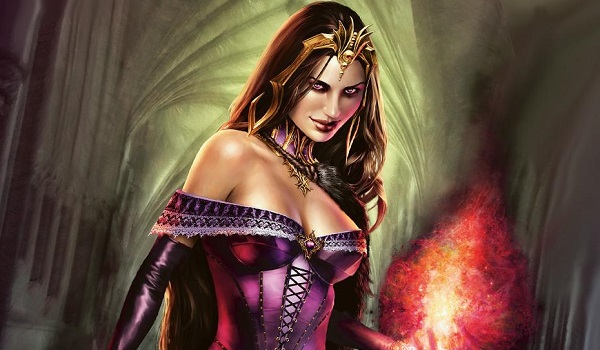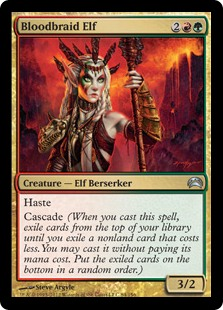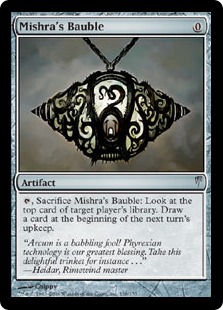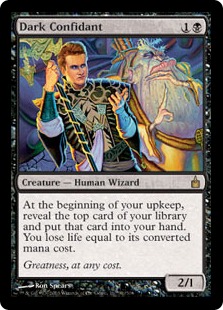Are you a Quiet Speculation member?
If not, now is a perfect time to join up! Our powerful tools, breaking-news analysis, and exclusive Discord channel will make sure you stay up to date and ahead of the curve.
I am always amazed at how often people make relatively simple tasks hard for themselves. There just seems to be something in all of us that gets suspicious whenever anything is unexpectedly easy. We are ready for conflict. We prepare for projects, lessons, and assignments to be hard. When they're not, we don't know what to do. I have colleagues and students that simply will not believe that something they think is hard is actually easy. And then set out to make it as hard as they think it should be.
I am not immune to this paradox. I knew I was going to test Bloodbraid Elf in a midrange Jund shell. There wasn't any doubt. It's in my own rules to test the deck that got the card banned. I've even written about the effect Bloodbraid had in older lists. It was gong to happen. However, I still tried to avoid it.

The problem was that midrange Jund just doesn't put up results anymore. It was barely 2% of the metagame last year. Initially, the drop off was due to Jund Death's Shadow, but over the year both decks were replaced by Grixis Death's Shadow. It has proven itself the better Thoughtseize deck, and other Thoughtseize decks struggle to compete. This drop off made me curious if there was another option. I knew it wouldn't pan out, but I pressed ahead. This article documents my failure.
Prelude
 I know a lot of current and former Jund players. One is on my testing team; specifically, the guy from my original proof-of-point test. When I first asked the team who was in for testing Bloodbraid Elf, he asked what version I was testing it in, midrange or Death's Shadow. I told him to recheck his inbox because I had already asked him that same question—since neither Jund deck had been doing well in 2017, I really didn't know which deck I should use. My gut said midrange, but it seemed like the Shadow variant was also viable. He was less certain about Shadow, but agreed that Death's Shadow itself made sense alongside Bloodbraid. He gave me some pointers on how to build the midrange version, but couldn't actually participate in testing. So it was up to me to see if there was anything to our intuition that Elf and Avatar could coexist.
I know a lot of current and former Jund players. One is on my testing team; specifically, the guy from my original proof-of-point test. When I first asked the team who was in for testing Bloodbraid Elf, he asked what version I was testing it in, midrange or Death's Shadow. I told him to recheck his inbox because I had already asked him that same question—since neither Jund deck had been doing well in 2017, I really didn't know which deck I should use. My gut said midrange, but it seemed like the Shadow variant was also viable. He was less certain about Shadow, but agreed that Death's Shadow itself made sense alongside Bloodbraid. He gave me some pointers on how to build the midrange version, but couldn't actually participate in testing. So it was up to me to see if there was anything to our intuition that Elf and Avatar could coexist.
Classic Bloodbraid Jund
Bloodbraid Elf has always been a midrange card. I remember that it saw some play in aggro decks when it first came out, but not for long. Cascade finds a random card off the top of your deck. There's never been an opportunity to set your top up for the Elf in any non-Legacy format, which has meant that every card needs to be a good hit. You don't want to waste your cascade on filler or support cards. The greater the individual cards' power, the greater the benefit of the cascade.
Of course, simply playing high impact cards isn't possible in Modern. Jund needs cheap interaction to survive. You just want to bias your interaction, particularly removal, towards being as universally useful as possible. Consider this list from the height of Jund's reign:
Jund, by Jeremy Dezani (1st, GP Lyon 2012)
I have no idea why Jeremy was playing Treetop Village. Other Jund lists of this era ran Raging Ravine, so assuming it's not a reporting error, I guess he couldn't find Ravines for the GP. It worked, and he won the GP, but it's still strange. Other than that oddity, the deck is functionally identical to Yuuya Wantanabe's list from the Players Championship. Besides Jund's requisite discard spells, every card hits hard with cascade. That's why the removal suite is biased towards versatility with Abrupt Decay and Maelstrom Pulse, with only one Exterminate!. When designing my test deck, I kept this lesson firmly in mind.
Death's Shadow Jund
Death's Shadow Jund (hereafter referred to as DSJ) is the midrange Shadow deck that started it all. Ever since Grand Prix Vancouver last February, Death's Shadow has defined Modern. While the trend started with DSJ, the deck has been increasingly overshadowed by Grixis Death's Shadow (GDS), to the point it doesn't even place in our tierings. Enough has been written about why this happened that I won't elaborate beyond saying that Grixis has proved more powerful. However, DSJ continues to put up results and is a very potent deck.
Jund Death's Shadow, by DJ Deficcio (SCG Modern IQ 2nd Place)
Grixis Shadow tends to play like a weird midrange deck. Most of what you're actually doing is midrange, but at aggro-combo speeds. DSJ is decidedly aggro-combo, using its discard more defensively so it can drop enormous threats with impunity and then rapidly killing the opponent. Grinding is an afterthought relative to Grixis, and is mostly done out of the sideboard. Adding Bloodbraid to the deck will necessarily slow it down and make it more grindy, but given that the pure speed plan isn't really working right now, I reasoned that it was a worthwhile change and decided to start with just repurposing existing lists.
First Try
My first attempt simply forced Bloodbraid into a Shadow list. Everyone I asked for advice was really skeptical; it's an 18-land deck, and I'm trying to play a four-of four drop. The thought defies logic. However, I'm persistent and persuasive enough to extract necessary information and was told that Abrupt Decay and Temur Battle Rage are the weakest inclusions. They are frequently necessary, but they're not standouts or even that amazing. I started here:
Bloodbraid Shadow 1.0, test deck
I wanted to preserve as much of DSJ's identity as possible. That meant keeping the Traverse package, low land count, and all the discard. I made the deck and had my doubts about its viability, but saw it as a prototype list. I'd do some exploratory testing and make changes as I went.
What I found was a dead end. I won games, but it didn't feel like a cohesive deck. It's the kind of deck that startles your FNM but never goes further than that. Since I was committed to using actual good decks whenever possible, I had to scrap this version.
The Problem
DSJ plays a suprisingly high number of bad cards. Yes, the whole is much greater than the sum of its parts, but many of those parts are underpowered and/or awful cascade hits. Cascading for value requires all the parts to be as good as possible. I don't really need to explain that Stubborn Denial is as bad as it gets. There's a reason Bloodbraid was never paired with blue cards back in the day. Many cards here are far more situational and narrow than typical Jund cards, which really limits the power of cascade.
 Consider Mishra's Bauble. It's played because it cantrips and fuels delirium for no mana. Between the importance of Traverse and the low land count, this is a fine card. However, it's a strikingly poor cascade hit on turn four. Hitting Traverse is also quite bad. Being able to search up Bloodbraid is great, but you want your cascade card to impact the board immediately.
Consider Mishra's Bauble. It's played because it cantrips and fuels delirium for no mana. Between the importance of Traverse and the low land count, this is a fine card. However, it's a strikingly poor cascade hit on turn four. Hitting Traverse is also quite bad. Being able to search up Bloodbraid is great, but you want your cascade card to impact the board immediately.
Surprisingly, actually casting Bloodbraid was rarely an issue. While the deck is meant to only run on two or three lands, it's relatively easy to get to four. You have eight cantrips and Traverse if needed, so you can get to four if you want to. It's just that the deck didn't want to. I felt like I was pushing against the deck's tendencies by playing Bloodbraid. I tried a few different configurations, including taking out blue and putting back in Battle Rage, to alleviate these problems, but it never felt good enough. It was proving too hard to reliably have delirium and strong cascade hits. While balance could be reached, it was much worse than choosing one or the other. So I tried something new.
Appropriating Grixis Shadow
Rather than try to fit a four drop into an 18 land deck, I decided to try and hybridize midrange and DSJ. I was still convinced that Shadow and Bloodbraid wanted to be in the same deck. Of course, how was an open question. Death's Shadow requires plenty of ways to control your life total while midrange Jund just wants to out value your opponent. This tension is actually present in GDS and it works there, so I figured that if I just used that as a guide, I could make a functional Bloodbraid Shadow list.
Bloodbraid Shadow 2.0, test deck
I opted not to go up to 12 fetches like Grixis, because Raging Ravine is great in Jund. Also, where the other Shadow decks have cantrips, I had cascade hits. Between that decision and playing Bloodbraid, I had to play more lands than any other version, but Ravine is kind of a spell so it balances out. Not having all of the fetches wasn't much of a problem; I didn't have trouble getting under 13 life in my testing. I had the best black threat, the Jund removal package, and the best modular spell, as well as Bloodbraid Elf to glue it all together. It seemed like a perfect plan.
The Problem
Unfortunately, the pieces just didn't fit together. The gears were trying to mesh but were grinding too harshly to be viable. Part of the problem was the lack of grease. Cantripping is integral to the other versions, which is why they flow so well. This version had only Street Wraith, and it underwhelmed. Grixis and DSJ use Wraith as delirium and delve fuel. I was just using it to make Shadow work. It really wasn't doing enough for the deck.
 Jund has traditionally gotten around its lack of cantrips with repeatable card draw (specifically Dark Confidant) and pure card quality. Its raw power made up for any other problems. While I was certainly playing powerful cards in this version, it wasn't quite enough. Shadow requires support. It's not like typical Jund creatures, where you can just slam it down and have it be good; you have to set it up. The hoops I had to jump though to support Shadow with this build got in the way of the Jund plan.
Jund has traditionally gotten around its lack of cantrips with repeatable card draw (specifically Dark Confidant) and pure card quality. Its raw power made up for any other problems. While I was certainly playing powerful cards in this version, it wasn't quite enough. Shadow requires support. It's not like typical Jund creatures, where you can just slam it down and have it be good; you have to set it up. The hoops I had to jump though to support Shadow with this build got in the way of the Jund plan.
Still, I think the problem is just in execution, not conception. Jund has the tools so that you don't normally have to worry about cascading into an unplayable Death's Shadow, and the problems I mentioned may be fixable with time and testing. I am convinced that the list I was searching for exists and that Bloodbraid and Shadow can do scary things together. It just won't be found by me.
Settling for Midrange
I wasn't ready to give up on Bloodbraid Shadow, but I had to move on. I'd used up all the exploratory time I'd allocated myself and didn't have a working deck. I really needed to get moving on testing if I was to get it all done before February. Therefore, I had to do what I was always planning on doing anyway and just fit Bloodbraid into an existing midrange shell. I'm not particularly happy about it, because I believe that should Bloodbraid actually be unbanned it will be played alongside Death's Shadow, and I really wanted to test that deck. It just wasn't to be. Next week, I'll reveal the test decks and the qualitative results.




When I saw the pt. 1 of this series, I immediately tried to brew a Bloodbraid Elf and Death’s Shadow list. I couldn’t get all the testing I wanted but I ended up on this:
https://tappedout.net/mtg-decks/jund-shadow-bbe/
Like you said, the cascades are not always incredible but I do believe is a very powerful deck and BBE helps against the control matchups.
I think I had a version almost exactly like this at one point. It was fine, but not quite there. Just a little too clunky to actually use.
If I may, it seems to me like the solution is to run the Shadow package (Wraith/Seize/Shadow) and not the delirium package (Bauble/Traverse). The latter is what gives you crummy cascades, and the consistency boost it affords is less necessary when you have a higher density of power cards anyway (now Shadow + Goyf + BBE). I’d start with the Shadow bare-bones, fill out the rest of the shell with good Jund cards, and let BBE do the rest.
If I have the opportunity to revisit this, that is definitely where I’d start.
I’m going to register my skepticism regarding Bloodbraid and Shadow being in the same deck. I think your testing illustrates how their requisite support cards don’t mesh all that well together, and I don’t think there’s any real way to fix that problem. You can’t run Bob in the same deck as Shadow, but you’d usually love to flip Bob off a Bloodbraid. The tight, highly efficient Shadow shell can’t really afford to run 4 copies of Liliana of the Veil, but that’s exactly the kind of density Bloodbraid would want in order to increase the likelihood of flipping it (and Bloodbraid into Liliana was generally considered to be an almost-backbreaking play). I think BBE’s return will be a boost to classic Jund first and foremost, and any collaboration it has with Shadow will be on scattered players’ pet decks.
It’s strange, I consistently felt like I was only a card or two away from making it work and that a Jund master could have gotten there. Admittedly, I’m not the most objective judge of these things.
In the event of an unban, you’re absolutely right, everyone and their hamster wheel will be on midrange Jund. I’m just not sure if that’s still correct.